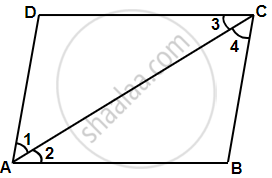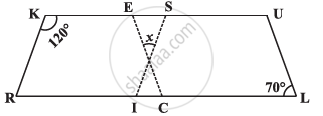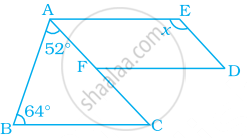Advertisements
Advertisements
Question
A diagonal of a parallelogram bisects an angle. Will it also bisect the other angle? Give reason.
Solution
Let ABCD is a parallelogram.
Given: ∠1 = ∠2
Now, ABCD is a parallelogram.
So, ∠1 = ∠4 [Alternate angles] ...(i)
Also, ∠2 = ∠3 [Alternate angles] ...(ii)
Now, ∠1 = ∠2 ...[Given]
Hence, ∠3 = ∠4 ...[From equation (i) and (ii)]
APPEARS IN
RELATED QUESTIONS
Can a quadrilateral ABCD be a parallelogram if ∠D + ∠B = 180°?

In the above figure both RISK and CLUE are parallelograms. Find the value of x.
Ratio of two adjacent sides of a parallelogram is 3 : 4, and its perimeter is 112 cm. Find the length of its each side.
Ratio of consecutive angles of a quadrilateral is 1 : 2 : 3 : 4. Find the measure of its each angle. Write, with reason, what type of a quadrilateral it is.
ABCD is a parallelogram. What kind of quadrilateral is it if: AC is perpendicular to BD but is not equal to it?
In parallelogram ABCD, X and Y are midpoints of opposite sides AB and DC respectively. Prove that:
(i) AX = YC
(ii) AX is parallel to YC
(iii) AXCY is a parallelogram.
Use the information given in the alongside diagram to find the value of x, y, and z.

If two adjacent angles of a parallelogram are (5x – 5)° and (10x + 35)°, then the ratio of these angles is ______.
Two angles of a quadrilateral are each of measure 75° and the other two angles are equal. What is the measure of these two angles? Name the possible figures so formed.
In the following figure, FD || BC || AE and AC || ED. Find the value of x.

